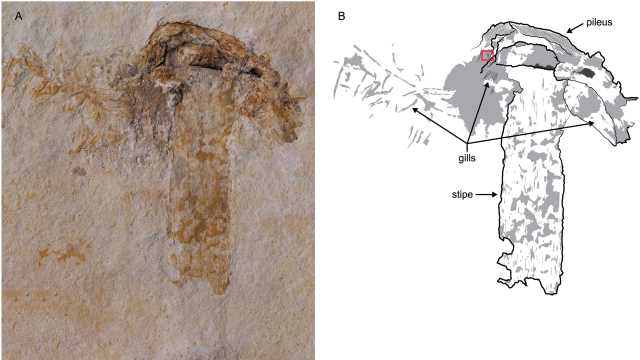Sam Heads and his team had just received a donation of fossil insects at the Prairie Research Institute, University of Illinois at Urbana-Champaign. But when they started going through it, Heads realised that one of the fossils wasn’t a bug at all. “It looks like a mushroom,” he said. He showed it to a colleague. “It looks like a mushroom,” the colleague said. They brought it to their mushroom expert (a mycologist), Andrew Miller. “That’s a mushroom,” he said.
The team analysed its sample, then did a literature review of all the papers on fossilised mushrooms. It wasn’t just a mushroom they’d found. It was the oldest fossilised mushroom.

Image: Sam Heads
“It was a bit of surprise,” Heads told Gizmodo. It was in a collection of fossil insects, after all.
The team named their find Gondwanagaricites magnificus, essentially meaning that it was a magnificent mushroom from the Gondwana supercontinent. It comes from Brazil’s Crato formation, a spot with lots of especially well-preserved fossil deposits, called Lagerstätten. Based on that information, the fossil is probably between 113 and 120 million years old.
Soft tissue normally decomposes, so fossils like these are especially useful for finding new species that would be lost to time otherwise. Other scientists had found the now-second oldest mushroom in Burmese amber.
As for the identity or how it’s related to modern mushrooms, that’s less certain. G. magnificus might look like more modern mushrooms but mycologists often use the shape of their spores, pre-mushrooms, to determine what species they are. This sample didn’t have any spores, according to the research published last week in PLoS One.
And palaeontologist Thomas Holz Jr did point out on Twitter that this is the oldest mushroom, not the oldest fungus.
#PLOSONE: The oldest fossil mushroom https://t.co/tbWWCggV5R (That’s specifically “mushroom”: the Fungi as a whole are much older)
— Thomas R. Holtz, Jr. (@TomHoltzPaleo) June 7, 2017
I’ve asked some mycologists to take a look to see if they could give me some more answers as to the mushroom’s identity. Roy Halling, mycologist from the New York Botanical Garden, told Gizmodo in the email that the authors were very good at not going overboard with speculation about the mushroom. “Definitely pretty cool,” he wrote. I did send the paper to Dr Khalid Hameed, a mycologist from Duke University, who immediately thought it looked like an Agaricus mushroom, the same genus that that includes field mushrooms and the common edible mushrooms (which includes portobello and cremini mushrooms).
With that information in hand, I asked Heads if he thought you could eat this ‘shroom. “My general approach to these things is if you don’t know what it, is don’t eat it.
[PLoS One]
